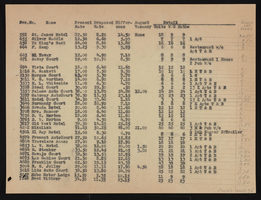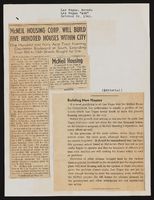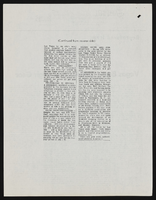Search the Special Collections and Archives Portal
Search Results
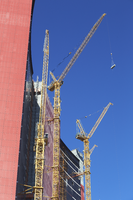
Cranes at the Resorts World Las Vegas project, looking west in Las Vegas, Nevada: digital photograph
Date
2020-02-06
Archival Collection
Description
Photographed as part of the UNLV Special Collections and Archives' Building Las Vegas collecting initiative started in 2016. This photo series documents ongoing construction work at the Resorts World Las Vegas site.
Image
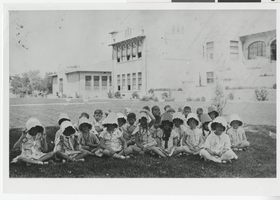
Photograph of a class from the Las Vegas Grammar School, Las Vegas (Nev.), 1935-1945
Date
1935 to 1945
Archival Collection
Description
A class of children sitting on the lawn at the Las Vegas Grammar School. The girls are wearing ruffled sun bonnets. Officially called the Las Vegas Grammar School, the complex has informally been referred to as the Fifth Street School almost since its inception, due to its location on Fifth Street (renamed Las Vegas Boulevard in 1959) in downtown Las Vegas. The complex functioned as a school, each year serving between 150 to 200 students in grades first through eighth, until 1966. It sat empty until 1970, when it was converted into Clark County offices. It was acquired by the city of Las Vegas from the county in 1996. Now officially called the Historic Fifth Street School, the building and its site are listed in the National Register of Historic Places and the city of Las Vegas Historic Property Register. Site Name: Las Vegas Grammar School (Las Vegas, Nev.) Street Address: 401 South Las Vegas Boulevard
Image
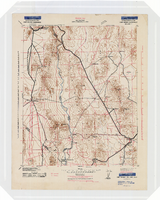
Topographic map of the Camp Mohave quadrangle in California, Nevada and Arizona, 1942
Date
1942
Description
Scale 1;250,000 ; polyconic projection (W 115°--W 114V/N 36V--N 35V) ; 1 map : col. ; 52 x 37 cm ; Relief shown by contours and spot heights. Contour interval 250 feet ; "Training map"--Center of upper margin of map ; "Base compiled from U.S. Geological Survey quadrangles. Control from U.S. Geological Survey. Revised from state highway maps for Arizona, Nevada and California" ; "Culture revisions shown in red based on reconnaissance by 67th Engr. Co. (Top.). May not be of same accuracy as base map." ; Map shows roads, trails, ponton sites, dam sites, possible air fields, possible landing fields, airports, water points, and impassable areas ; Map was originally restricted. "Classification cancelled by authority of Chief of Engineers letter of Jan. 22, 1946." ; Title at top of map: Nevada-Arizona-California : Camp Mohave quadrangle : grid zone F ; Army Map Service, U.S. Army.
Image
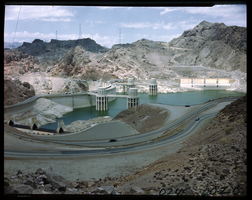
Film transparency of Hoover (Boulder) Dam, taken from the upstream side of the dam on the Arizona side, May, 1947
Date
1947-05
Archival Collection
Description
Hoover (Boulder) Dam, taken from the upstream side of the dam on the Arizona side, May, 1947. The intake towers, Nevada spillway house (in the background, behind the intake towers), and the Nevada spillway are visible. During the years of lobbying leading up to the passage of legislation authorizing the dam in 1928, Hoover Dam was originally referred to "Boulder Dam" or as "Boulder Canyon Dam", even though the proposed site had shifted to Black Canyon. The Boulder Canyon Project Act of 1928 (BCPA) never mentions a proposed name or title for the dam. When Secretary Wilbur spoke at the ceremony starting the building of the railway between Las Vegas and the dam site on September 17, 1930, he named the dam "Hoover Dam", citing a tradition of naming dams after Presidents, though none had been so honored during their terms of office. After Hoover's election defeat in 1932 and the accession of the Roosevelt administration, Secretary Ickes ordered on May 13, 1933 that the dam be referred to as "Boulder Dam". In the following years, the
Image
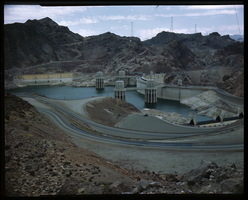
Film transparency of Hoover (Boulder) Dam, taken from the upstream side of the dam on the Nevada side, May, 1947
Date
1947-05
Archival Collection
Description
Hoover (Boulder) Dam, taken from the upstream side of the dam on the Nevada side. May, 1947. The intake towers, Nevada spillway house (in the background, behind the intake towers), and the Nevada spillway are visible. During the years of lobbying leading up to the passage of legislation authorizing the dam in 1928, Hoover Dam was originally referred to "Boulder Dam" or as "Boulder Canyon Dam", even though the proposed site had shifted to Black Canyon. The Boulder Canyon Project Act of 1928 (BCPA) never mentions a proposed name or title for the dam. When Secretary Wilbur spoke at the ceremony starting the building of the railway between Las Vegas and the dam site on September 17, 1930, he named the dam "Hoover Dam", citing a tradition of naming dams after Presidents, though none had been so honored during their terms of office. After Hoover's election defeat in 1932 and the accession of the Roosevelt administration, Secretary Ickes ordered on May 13, 1933 that the dam be referred to as "Boulder Dam". In the following years, the n
Image
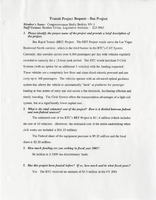

Transcript of interview with Shirley Faye Helmick by Lyle Helmick, May 12, 1978
Date
1978-05-12
Archival Collection
Description
On May 12, 1978, Lyle Helmick interviewed his mother, Shirley Helmick (born March 7, 1930 in Colorado), in her home in Las Vegas, Nevada. The two discuss Helmick’s personal history, occupational history, and reasons for moving to Nevada. The interview concludes with Helmick explaining events that the United Methodist Church hosts.
Text
Pagination
Refine my results
Content Type
Creator or Contributor
Subject
Archival Collection
Digital Project
Resource Type
Year
Material Type
Place
Language
Records Classification

